Table of Contents ![]()
PESTLE Analysis: Definition, Template & Examples
What is PESTLE Analysis
PESTLE analysis is a strategic management tool that businesses use to identify macro-economic factors that it needs to consider. The word ‘PESTLE’ stands for the six factors – Political, Economic, Social, Technological, Legal, and Environmental. Together, they form the basis for identifying key issues that may impact the strategic direction of the company.
The PESTLE analysis is a useful tool to help management decide between two strategic options. For example, management may consider developing a new product, or, expanding into a new country. The PESTLE analysis helps with this decision by looking at the four key factors and identifying advantages and disadvantages for each.
When management looks to expand into a new country, political factors are crucial. For instance, is there corruption? What are the tax laws like? Are there significant regulatory hurdles? Management needs to consider all such factors – and that is what the PESTLE Analysis template does.
Key Points
- A ‘PESTLE’ analysis looks at six key factors – Political, Economic, Social, Technological, Legal, and Environmental.
- The PESTLE analysis is a strategic tool that aims to identify factors that are limiting profitability, or areas that can enhance profitability.
- PESTLE Analysis helps to find opportunities, threats, strengths and weaknesses – similar to a SWOT analysis, but in more detail.
PESTLE Analysis Template
The PESTLE Analysis template covers the six factors – Political, Economic, Social, Technological, Legal, and Environmental. There were only originally four factors that formed ‘PEST’ – Political, Economic, Social, and Technological. However, over the years this has been expanded to also cover two other factors in Legal and Environment to become more encompassing of all the variables at play in the macro-economic environment.
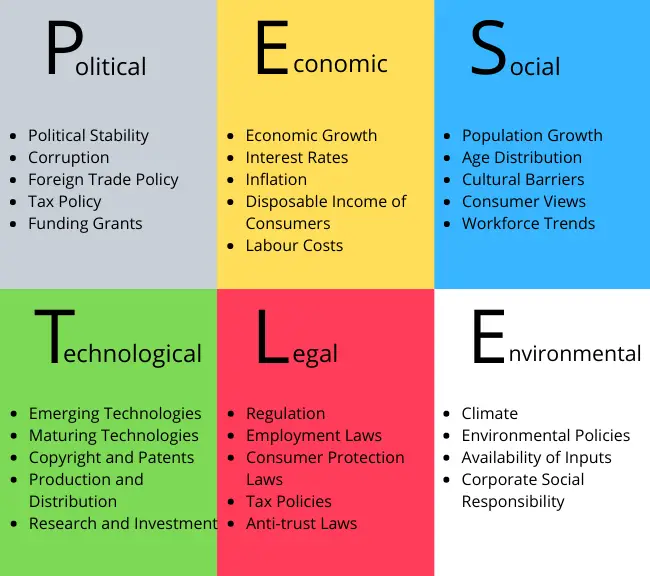
Political Factors
When looking at political factors, we need to look at what may affect a specific strategic option. For instance, when looking to expand abroad, it is important to recognize political issues that may add cost, time, and effort to the project.
Whilst there are many political factors, the main examples include:
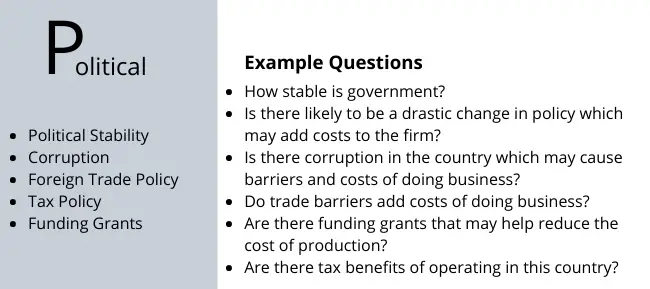
1. Political Stability
Political stability refers to how secure the incumbent government is. For instance, is there likely to be a change and subsequent shift in political direction? This is particularly an issue when the shifts are significant. There may be a large shift towards more socialist policies, or, they may be a shift towards more conservative policies.
Whatever the shift is, it is the uncertainty that can create an issue. For example, significant levels of uncertainty occurred in the aftermath of the United Kingdom’s Brexit vote – particularly due to the weak government that caused great levels of political uncertainty at the time.
As part of the PESTEL analysis, you would want to ask questions such as:
- How would a shift in the political direction affect this decision?
- Would a shift in one direction be more profitable than another?
- How significant is the instability?
2. Corruption
Corruption refers to both the public and private markets. For instance, does it take $50 as a bribe to get through customs? Do political leaders expect pay-offs in return for favours? These factors not only affect the profitability, but also the integrity of the company.
If we look at China, for example, there are still high levels of corruption present – even though there has been a nationwide crackdown. Bribes are still commonplace, with businesses forced to pay in order to be able to distribute and sell their goods.
As part of the PESTEL analysis, you would want to ask questions such as:
- How widespread is the corruption?
- Is the government doing anything about it or are they also involved?
- Is the corruption region-specific?
3. Foreign Trade Policy
Foreign trade policy refers to the barriers government puts up. For instance, it may impose restrictions on goods coming in and out – as well as tariffs on inputs coming in. These restrictions can make it more expensive – particularly for businesses that rely on the international supply chain.
If we look at car manufacturers in India – they require many goods such as tires, glass, metal, and electronic components. Many of these will need to be imported in. Yet if there are high tariffs on these goods, it can make it more expensive than originally anticipated.
As part of the PESTEL analysis, you would want to ask questions such as:
- What are the main restrictions on trade I.e. tariffs or quotas?
- How much would this cost the firm?
- Will trade barriers increase? (as they have between the US and China)
4. Tax Policy
Tax policies refer to the existing tax regime in place. So how much corporation tax is due and what other taxes may be applicable? A higher corporation tax might be enough to put many businesses off – even if labour costs are lower.
As part of the PESTEL analysis, you would want to ask questions such as:
- What are the applicable taxes that are due?
- Is there any political pressure for these to increase in the future?
5. Funding Grants/Incentives
Governments often offer grants and other subsidies to attract investment. Such financial incentives could help reduce costs and provide a new source of revenue.
As part of the PESTEL analysis, you would want to ask questions such as:
- What grants or subsidies are available?
- How financially beneficial are these incentives?
- Are they likely to remain in place in the future?
Economic Factors
There are several economic factors that we need to consider when conducting a PESTEL analysis. Let us look at some of the main ones below:
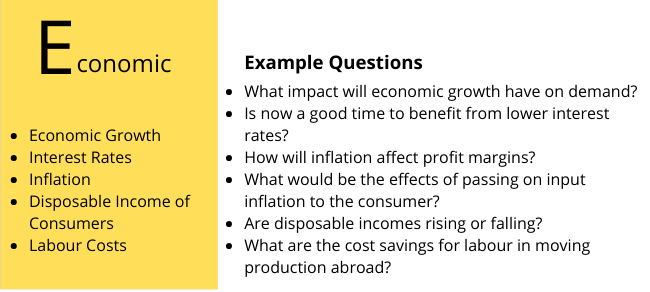
1. Economic Growth
Not only is current economic growth important, but also future growth. If future growth is forecast to slow, then the investment may not pay off in the same way. With strong economic growth, consumer demand will rise – therefore presenting growth opportunities for the firm.
As part of the PESTEL analysis, you would want to ask questions such as:
- What is current and forecast economic growth?
- What impact will this have on for the demand for the businesses products?
- Are certain industries in the economy growing faster than others?
2. Interest Rates
Almost every business has debt, which makes the amount of interest they have to pay, crucially important. As interest rates go up, the more it costs a business to make an investment.
As part of the PESTEL analysis, you would want to ask questions such as:
- What is the interest rate at the moment?
- How does this compare to historical averages?
- Is credit cheaper now than it has been before?
3. Inflation
Inflation can cause significant costs to businesses. First of all, the price of its inputs will start to increase – thereby putting pressure on profit margins. It may decide to pass these on to the consumer, but this will likely lose them custom. So either profit margins can be affected, or final consumer demand. In turn, particularly high levels of inflation put cost pressures onto businesses which may make a large investment unfeasible.
As part of the PESTEL analysis, you would want to ask questions such as:
- How would inflation affect profit margins?
- What is the current and forecast rate of inflation?
- What would be the effects of passing on input inflation to the consumer?
4. Disposable Income of Consumers
When disposable income is low, it may signal an opportunity for low budget goods. It may also signal that it is the wrong time to make a significant investment in a new high-end luxury products. These signals can lead to many conclusions depending on whether disposable incomes are rising or falling. In turn, there are important strategic factors that need to be taken into consideration.
As part of the PESTEL analysis, you would want to ask questions such as:
- Are disposable incomes rising or falling?
- Can we expect disposable incomes to rise significantly in the future?
- What impact does the current and future levels of disposable income have on the firms demand?
5. Labour Costs
Labour costs are one of the biggest expenditures for a firm. At the same time, labour costs can be well worth it if it is highly productive. This cost-analysis between productivity and labour is an important aspect of the PESTLE analysis. For example, would it be efficient to operate in India with labour prices at 10 percent the current rate, but also 20 times less productive? These are issues that the analysis has to address.
As part of the PESTEL analysis, you would want to ask questions such as:
- What are the cost savings for labour?
- Would the potential productivity loses make this financially beneficial?
- Are there any other additional labour costs, I.e. pension contributions that need to be considered?
Social Factors
The social element of the PESTLE analysis covers aspects from culture and demographics to general social trends in the economy. How will these factors affect the profitability of an investment? For example, a country such as Japan, which is experiencing a decline in its population, is a shrinking market. With the population declining, there are fewer consumers to buy goods and services in the long-term future.
There are many social factors to consider in the PESTLE analysis. Let us look at the main ones below:
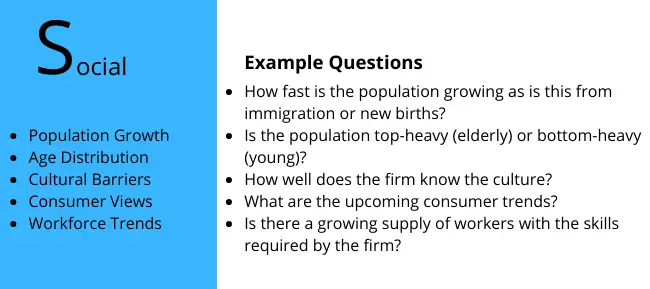
1. Population Growth
As already discussed, population growth or decline can gradually increase or decrease the potential customer base. At the same time, it is important to find the cause of population growth. Is it immigration or new births? If immigration, then there is an opportunity to capture them as new consumers into the market. By contrast, new births present a different opportunity – largely in the fields of education, toys, and child’s clothing and entertainment.
As part of the PESTEL analysis, you would want to ask questions such as:
- How fast is the population growing?
- Is the population growth from immigration or new births?
- What can the firm provide to take advantage of this trend?
2. Age Distribution
An old population will demand different types of goods and services when compared to a younger population. For instance, a young population may favour technological goods. In turn, this can help the firm target either the elder or younger demographic – thereby altering the final good to suit.
As part of the PESTEL analysis, you would want to ask questions such as:
- Is the population top-heavy (elderly) or bottom-heavy (young)?
- What will the distribution look like over the next 10 – 20 years?
- How will the change in age distribution affect demand for the firms product over the next 20 years?
3. Cultural Barriers
Many firms have entered new markets and failed because they did not understand the culture. We have seen firms such as Carrefour fail in China because they expected the rising middle class to act like those in the west. The view was that the Chinese middle class would do big shops at the firm’s hypermarkets. However, the Chinese prefer to do small shops – leaving the hypermarket as an unnecessarily expensive option.
As part of the PESTEL analysis, you would want to ask questions such as:
- Is there evidence to support our cultural assumptions? i.e. are middle-class consumers going to shop as we expect – as is the case with Carrefour?
- How well do we know the culture?
- Is the general culture outside of the firm’s market different? If so, more consideration is needed.
4. Consumer Views
Consumer views cover everything from the industry to the firm’s specific brand name. For instance, consumer’s views on healthy food have changed dramatically over the last few years – opening up both an opportunity and a threat. At the same time, consumer’s views may change if the trust in the brand is damaged. For example, Volkswagen’s emissions scandal in 2015 has affected its credibility and sales as a result.
As part of the PESTEL analysis, you would want to ask questions such as:
- How have consumer views of the firm’s market changed over the years?
- What are the upcoming consumer trends?
- How are existing consumer views affecting demand and how can these be overcome?
5. Workforce Trends
Some countries have a skilled workforce in a specific industry. For instance, London is a well-known financial hub with significant levels of market expertise. However, alternatives such as Frankfurt and Singapore have emerged over the years – providing a highly-skilled workforce.
As part of the PESTEL analysis, you would want to ask questions such as:
- Is there a growing supply of workers with the skills required by the firm?
- How will the existing supplier of skilled workers affect profitability?
Technological Factors
In business, technology is always evolving – helping the firm establish more efficient processes. This presents the firm with both an opportunity, but also a weakness. For instance, is the firm falling behind technological trends? Are there technological trends that the firm should be looking at?
There are many technological factors to consider in the PESTLE analysis. Let us look at the main ones below:
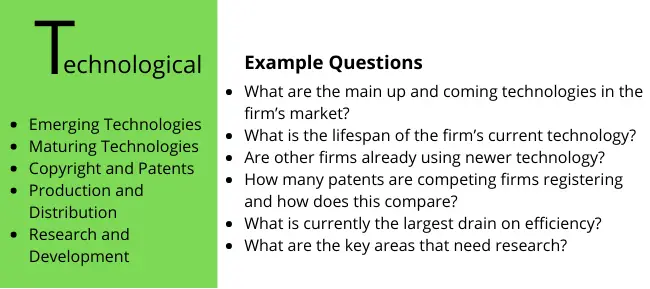
1. Emerging Technologies
Emerging technologies can be a hit or miss. Some are often seen as the next big thing but turn out to be a complete flop. For instance, virtual reality was meant to be the next big thing in gaming. Yet sales have been underwhelming and the hype has seemingly died out. With that said, there are also emerging technologies that can revolutionise the market – look at Netflix and video streaming for example.
As part of the PESTEL analysis, you would want to ask questions such as:
- What are the main up and coming technologies in the firm’s market?
- Is there a financially viable market for these technologies?
- Will these emerging technologies create a more efficient production process?
2. Maturing Technologies
As exciting as new technologies are – old technologies suffer a slow and painful death. The important thing for the firm is to identify these maturing technologies and look to replace them quickly. For example, Blackberry failed to adapt to the new technology surrounding the smartphone market. Its technology matured and became obsolete.
As part of the PESTEL analysis, you would want to ask questions such as:
- What is the lifespan of the firm’s current technology?
- What is the main threat to the firm’s existing technology?
- Are other firms already using newer technology?
3. Copyright and Patents
When entering into a new market or country, there are copyright laws that need to be adhered to. At the same time, patents and copyrights can prove a useful technique to prevent other firms from using that technology. Whilst some companies may not have an immediate need for it, it prevents others from doing so.
As part of the PESTEL analysis, you would want to ask questions such as:
- How many patents are competing firms registering and how does this compare?
- Are new patents targeting specific markets?
- When do competitor’s patents run out? This is particularly important in the pharma industry where the lifespan of drugs is significantly longer.
4. Production and Distribution
The production and distribution processes are a significant cost to the company. There may be a way by which a technological solution can improve the efficiency of such. For instance, self-driving trucks could lead to significant cost savings. Or, an increase in the number of self-serve kiosks. At the same time, it’s important to note the impact this may have on the final consumer.
As part of the PESTEL analysis, you would want to ask questions such as:
- What is currently the largest drain on efficiency?
- What can the firm do to address the inefficiencies?
- How much are inefficiencies costing the business?
- Would consumers like these technologies?
5. Research and Development
Most big companies conduct some level of research and development. However, how productive is it and what does it return on the investment? We also need to consider what competitors are doing. If they are discovering new technologies first, this puts the firm at a distinct disadvantage – particularly if they are patented.
As part of the PESTEL analysis, you would want to ask questions such as:
- How much are competitors spending on research and development?
- What is the current return on investment of the firm’s research and development?
- What are the key research areas?
Legal Factors
Failure to abide by the laws and regulations of the land not only costs the firm in financial terms but also the damage to its brand image and reputation. For instance, providing unsafe products not only violates consumer protection laws but significantly destroys trust in the brand.
There are many legal factors to consider in the PESTLE analysis. Let us look at the main ones below:

1. Regulation
Some countries have stricter regulatory requirements than others and this varies from industry to industry. Depending on the industry and the regulations, there can be significant costs of compliance. In turn, these costs have to be factored into the final price or the profitability of production.
As part of the PESTEL analysis, you would want to ask questions such as:
- What regulatory requirements does the firm need to adhere to?
- What is the estimated cost of these requirements?
- Are there any up-coming regulatory changes?
2. Employment Laws
Employment laws can make it incredibly to hire and fire people – thereby providing an incentive not to hire. In addition, there are laws on employee holidays, pension contributions, health benefits, and the number of working hours. Each of these presents a cost and increases the difficulty of doing business.
As part of the PESTEL analysis, you would want to ask questions such as:
- What are the existing employment laws?
- How much do these cost the firm?
3. Consumer Protection Laws
There are laws that are put in place to prevent unscrupulous businesses from taking advantage of the average consumer. Sometimes these can be helpful, but other times they can be overburdensome. As with many laws, they don’t necessarily make sense in the real world.
As part of the PESTEL analysis, you would want to ask questions such as:
- What consumer protection laws does the firm need to adhere to?
- Are the staff aware of these laws and trained to deal with them accordingly?
- Is the current production process fit and able to ensure these laws are adhered to?
4. Tax Policies
It might be corporation tax, income tax, employee tax, or a sales tax. Each one has an effect on how much an employee will cost and how much profit the firm can keep. At the same time, it is important to identify potential future changes in the tax code. If taxes are going up in two years, it will put the firm under additional financial pressure.
As part of the PESTEL analysis, you would want to ask questions such as:
- Are taxes likely to go up in the coming years, and if so, by how much?
- How do corporation taxes compare to other countries?
- What is the extra cost of administering these taxes?
5. Anti-trust Laws
The purpose of anti-trust laws is to ensure there is free and fair competition through the economy. That means preventing monopolies and cutting out corruptive practices by administering large fines and potential jail sentences.
As part of the PESTEL analysis, you would want to ask questions such as:
- Is this deal likely to pass through the anti-trust courts?
- Are staff trained to deal with suspected anti-trust cases?
Environmental Factors
As part of PESTLE, environmental factors cover those that are external to the company. Generally speaking, it covers the physical environment – such as climate change and environmental policies, as well as, the non-physical environment, such as NGO campaigns and corporate social responsibility to the local community.
There are many environmental factors to consider in the PESTLE analysis. Let us look at the main ones below:

1. Climate
Weather can be a crucially important factor for many countries. For transporting firms, it may be important to have air-conditioned or refrigerated vehicles – particularly for fresh foods. At the same time, the weather may present new opportunities. For example, cold drinks in hot climates and hot drinks in cold climates. No matter the climate, it is important for firms to identify what effect it will have on demand.
As part of the PESTEL analysis, you would want to ask questions such as:
- What impact does the climate have on how the firm does business?
- Does the warm/cold climate present an opportunity for diversifying the firm’s product offering?
- Does the climate provide better working conditions?
2. Environmental Policies
In today’s day and age, there is pressure from both the government, but also climate change protestors, for businesses to reduce their carbon footprint and use ‘green’ technologies. Whilst some governments are relaxed, others have strict targets – thereby creating additional costs to production.
As part of the PESTEL analysis, you would want to ask questions such as:
- Is the company doing enough to meet the environmental regulations?
- Are the firm’s carbon emissions damaging the companies brand image?
- What are the costs of compliance both in a potential market and the existing market?
3. Availability of Inputs
By locating close to the firm’s inputs, it can reduce transport costs, as well as potential sunk costs in the form of damaged goods. For instance, a steel manufacturer may want to locate near a coal mine – a core input in steel production. However, this may depend on the lifespan of the mines and proximity to skilled labour.
As part of the PESTEL analysis, you would want to ask questions such as:
- What is the most important input?
- Would it be cost-effective to move production closer to those inputs?
- Can the supply of inputs be relied upon?
4. Corporate Social Responsibility
Corporate social responsibility is an important aspect of business as it affects how the business is perceived by the public. This environmental factor looks at the impact the businesses day to day activities have on the firm’s brand image and public perception.
As part of the PESTEL analysis, you would want to ask questions such as:
- Is the company viewed favourably?
- How can the firm improve its popularity among the public?
- How does the company compare against its competitors? Do consumers view other firms more favourably?
FAQs on PESTEL Analysis
To do a PESTLE analysis, you need to look at the six factors that make up PESTLE – Political, Economic, Social, Technological, Legal, and Environmental. Then, you must analyse each factor independently. For example, what Political factors might be influential to Google? There are a number of countries that want to try and restrict its power, so there may be some restrictions coming. We also have technological – it updates its algorithm several times each year to stay on top.
PESTLE analysis is a strategic management tool that businesses use to identify macro-economic factors that it needs to consider. The word ‘PESTLE’ stands for the six factors – Political, Economic, Social, Technological, Legal, and Environmental. Together, they form the basis for identifying key issues that may impact the strategic direction of the company.
PESTLE Analysis helps to find opportunities, threats, strengths and weaknesses – similar to a SWOT analysis, but in more detail.
About Paul
Paul Boyce is an economics editor with over 10 years experience in the industry. Currently working as a consultant within the financial services sector, Paul is the CEO and chief editor of BoyceWire. He has written publications for FEE, the Mises Institute, and many others.

Further Reading
 Determinants of Supply - Determinants of supply are the factors that influence the quantity of goods or services that producers are willing and able…
Determinants of Supply - Determinants of supply are the factors that influence the quantity of goods or services that producers are willing and able…  Accounting Equation - The accounting equation represents the fundamental relationship between a company's assets, liabilities, and owner's equity.
Accounting Equation - The accounting equation represents the fundamental relationship between a company's assets, liabilities, and owner's equity.  Central Limit Theorem - The central limit theorem states that as the sample size increases, the sampling distribution of the sample mean approaches a…
Central Limit Theorem - The central limit theorem states that as the sample size increases, the sampling distribution of the sample mean approaches a… 